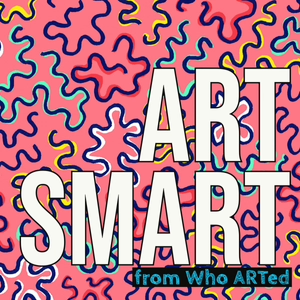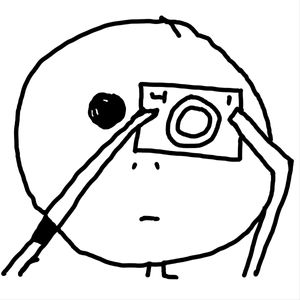
Modern Art
07/20/22 • 10 min
4 Listeners
Most art historians tend to say the shift to modernism started in the mid to late nineteenth century. This was an era of rethinking the old rules, breaking free from the established traditions and experimenting with new ways of working. There is not one specific artwork that ushered in the modern era. It was not birthed on one specific day. It was an evolution, but if I were to look for a dividing line I would say that the modern era started around the time that Daguerre gave us his photographic method. Photography becoming more accessible changed the way artists worked. Painters were liberated in a way because they no longer needed to focus on capturing an accurate likeness. Those who wanted realistic pictures could simply take a photograph. Of course, the new technology could also threaten their livelihood as patrons could now choose between a painting and a photograph for their portraits. Regardless of whether artists considered the new technology as an opportunity or a threat, the end result was artists experimenting and becoming more abstract. They focused on things the camera could not capture. At first, the Impressionists looked at color, then Post-Impressionists moved on to the expressive qualities. As I said the work became increasingly abstract until artists like Jackson Pollock were simply dripping paint onto the canvas. So what is the connection between Impressionists focusing on what they saw and Jackson Pollock’s action painting? Why do all of these movements fall under the modern umbrella? I would say the through line with modernism is a philosophy rooted in the idea that artists could capture some objective truth that would make the work timeless and universal. The impressionists were focused on optics and how the human eye perceives color. The abstract expressionists ran with the modernist quest to distill art down to a fundamental essence and took it to its logical conclusion. They broke art down to the basic elements like line, color, and texture to create a sense of movement and an expressive composition that was free of specific subject matters which would have tied it to a time and culture.
Go to the Art Smart website (https://www.artsmartpodcast.com/art-erasmovements/modern-art) to see images of the artworks I mentioned as well as podcasts about those artists.
If you are looking for a little extra credit and want to learn more about the artists listed in this episode, check out the following episodes of Who ARTed:
Vincent van Gogh | The Starry Night
Wassily Kandinsky | Yellow Red Blue
Art Smart is an Airwave Media Podcast.
Connect with me:
Website | Twitter | Instagram | Tiktok
Support the show:
Merch from TeePublic | Make a Donation
One of the best ways to support the show is to help it grow. Tell a friend about it, or leave a rating or review on your favorite podcast app.
Learn more about your ad choices. Visit megaphone.fm/adchoices
Most art historians tend to say the shift to modernism started in the mid to late nineteenth century. This was an era of rethinking the old rules, breaking free from the established traditions and experimenting with new ways of working. There is not one specific artwork that ushered in the modern era. It was not birthed on one specific day. It was an evolution, but if I were to look for a dividing line I would say that the modern era started around the time that Daguerre gave us his photographic method. Photography becoming more accessible changed the way artists worked. Painters were liberated in a way because they no longer needed to focus on capturing an accurate likeness. Those who wanted realistic pictures could simply take a photograph. Of course, the new technology could also threaten their livelihood as patrons could now choose between a painting and a photograph for their portraits. Regardless of whether artists considered the new technology as an opportunity or a threat, the end result was artists experimenting and becoming more abstract. They focused on things the camera could not capture. At first, the Impressionists looked at color, then Post-Impressionists moved on to the expressive qualities. As I said the work became increasingly abstract until artists like Jackson Pollock were simply dripping paint onto the canvas. So what is the connection between Impressionists focusing on what they saw and Jackson Pollock’s action painting? Why do all of these movements fall under the modern umbrella? I would say the through line with modernism is a philosophy rooted in the idea that artists could capture some objective truth that would make the work timeless and universal. The impressionists were focused on optics and how the human eye perceives color. The abstract expressionists ran with the modernist quest to distill art down to a fundamental essence and took it to its logical conclusion. They broke art down to the basic elements like line, color, and texture to create a sense of movement and an expressive composition that was free of specific subject matters which would have tied it to a time and culture.
Go to the Art Smart website (https://www.artsmartpodcast.com/art-erasmovements/modern-art) to see images of the artworks I mentioned as well as podcasts about those artists.
If you are looking for a little extra credit and want to learn more about the artists listed in this episode, check out the following episodes of Who ARTed:
Vincent van Gogh | The Starry Night
Wassily Kandinsky | Yellow Red Blue
Art Smart is an Airwave Media Podcast.
Connect with me:
Website | Twitter | Instagram | Tiktok
Support the show:
Merch from TeePublic | Make a Donation
One of the best ways to support the show is to help it grow. Tell a friend about it, or leave a rating or review on your favorite podcast app.
Learn more about your ad choices. Visit megaphone.fm/adchoices
Previous Episode

BONUS: How to Understand Art
On Who ARTed, every week, I discuss a different work of art with a guest. I have been asked how I make sense of so many different artworks. Honestly, analyzing art did not come easily to me, and for a long time I felt uncomfortable discussing a piece because I wasn't very confident in my interpretations. I found that it helps a lot to approach things systematically. I go through three basic steps to understand any artwork.
If you enjoy this show, and want to learn more about art history, check out my other podcast, Who ARTed. Please help others discover the show by leaving a rating or review on your favorite podcast app.
Art Smart is an Airwave Media Podcast.
Learn more about your ad choices. Visit megaphone.fm/adchoices
Next Episode

Post Modern Art
Postmodernism is much more idiosyncratic (The Simpsons famously defined post modern as "weird for the sake of weird"). Postmodernism is rooted in sketpticism of the broad modernist narratives. Post modern philosophy is much more subjective and doubtful of certainty and stability of meaning. To be clear, there are objective and verifiable facts, but post modern philosophy tells us that people’s responses and interpretations of those facts are affected by tons of different factors from society and individual experiences.
For my Post Mosern Collection, here are my five picks:
- Marcel Duchamp - Fountain. While this piece was created right in the heart of the modern era, many critics and historians argue that the Dada movement was much in line with post-modern thought and laid the groundwork for postmodernism. If I am putting together a collection to help people understand post modernism, I would start with readymades.
- Roy Lichtenstein - Look Mickey
- Robert Smithson - Spiral Jetty
- Yayoi Kusama - Love is Calling
- Rober Raschenberg - Erased de Kooning
If you want to learn more, you can find images of those works along with podcasts to learn more about any works that catch your eye at www.artsmartpodcast.com
Art Smart is an Airwave Media Podcast.
Connect with me:
Website | Twitter | Instagram | Tiktok
Support the show:
Merch from TeePublic | Make a Donation
Learn more about your ad choices. Visit megaphone.fm/adchoices
If you like this episode you’ll love
Episode Comments
Featured in these lists
The best podcasts for Art Lovers
Curated by Kyle Wood
Generate a badge
Get a badge for your website that links back to this episode
<a href="https://goodpods.com/podcasts/art-smart-195532/modern-art-22144432"> <img src="https://storage.googleapis.com/goodpods-images-bucket/badges/generic-badge-1.svg" alt="listen to modern art on goodpods" style="width: 225px" /> </a>
Copy




